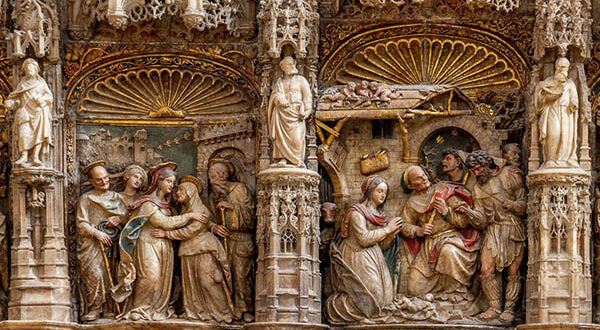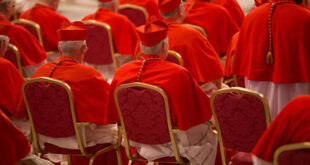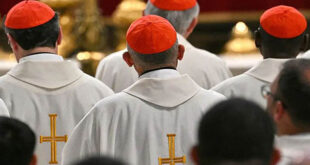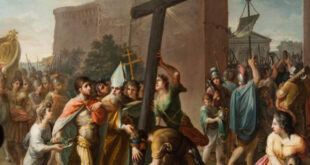Since time immemorial, the Church has used art as a means to communicate the truth of the faith. Among the most emblematic artistic expressions of traditional Catholicism is the altarpiece, a majestic structure that adorns the altars of churches and cathedrals, conveying the greatness of God and the richness of Christian doctrine.
In this article, we will explore the origin, symbolism, theological importance, and spiritual relevance of the altarpiece, then reflect on how this element of Catholic tradition can help us deepen our relationship with God today.
1. The Altarpiece: A Link Between Heaven and Earth
The term “altarpiece” comes from the Latin retro tabula, meaning “behind the table,” referring to its traditional location behind the altar. These structures, generally made of carved wood, stone, or precious metals, have been used since the Middle Ages to beautify the main altar and assist in the visual catechesis of the faithful.
More than a mere ornament, the altarpiece is a visual gateway to the divine mystery. Its primary function is to elevate the mind and heart toward God, presenting biblical scenes, images of Christ, the Virgin Mary, and the saints. Contemplating an altarpiece allows the faithful to experience what Psalm 27:4 expresses:
“One thing I ask from the Lord, this only do I seek: that I may dwell in the house of the Lord all the days of my life, to gaze on the beauty of the Lord and to seek Him in His temple.” (Psalm 27:4)
2. Structure and Elements of the Altarpiece
Altarpieces are usually organized into different levels and compartments, each with deep spiritual significance:
A) Predella or Base
This is the lower part of the altarpiece, located just above the altar. It often depicts scenes of Christ’s Passion or the Last Supper, reminding us that the altar is the place of the Eucharistic Sacrifice.
B) Main Body
This is the central and most visible part of the altarpiece, where the main images are placed. The central position is usually reserved for an image of Christ, the Virgin Mary, or the patron saint of the church. Surrounding this central figure are scenes from Christ’s life or key passages from Sacred Scripture.
C) Attic or Crowning Section
This is the upper part, often depicting heavenly glory. Frequently, it features an image of God the Father, the Holy Spirit in the form of a dove, or angels glorifying God. This arrangement recalls the hierarchy of heaven and the invitation to eternal life.
D) Columns and Decoration
The columns and ornaments surrounding the images serve a theological function: they symbolize the stability and solidity of the faith. In Baroque altarpieces, the dynamic and golden forms evoke the glory of Paradise.
3. The Theological Function of the Altarpiece
The altarpiece is not merely a decorative object but a tool for evangelization and spiritual contemplation. Its theological relevance lies in several aspects:
A) A Visual Catechism
For centuries, when most of the faithful were illiterate, altarpieces functioned as authentic “Bibles for the poor,” teaching the history of salvation through images. Even today, they remain a means to deepen faith.
B) A Reflection of the Mystery of the Liturgy
The Holy Mass is the re-presentation of Christ’s redemptive sacrifice. The altarpiece, with its hierarchical arrangement and orientation toward the altar, reminds us that the Mass is a gateway to heaven, where Christ is the center of everything.
C) A Call to Prayer and Contemplation
Sacred art helps us pray better. Looking at an altarpiece with devotion can be a means to meditate on the life of Christ and the saints, encouraging us to imitate their virtues. As St. Paul exhorts us:
“Set your minds on things above, not on earthly things.” (Colossians 3:2)
4. The Relevance of the Altarpiece in Spiritual Life Today
Although we live in a digital age where information is just a click away, the need for visible signs of faith remains essential. In an increasingly secularized world, altarpieces remind us that God is the center of our lives and that our goal is Heaven.
A) Fostering Devotion
Simply stopping before an altarpiece in a church, contemplating it, and meditating on its images can be a form of deep prayer. Why not recover this practice in our daily lives?
B) Returning to Sacred Beauty
Today, many churches have opted for a minimalist aesthetic, to the detriment of traditional symbolic richness. Rediscovering the importance of the altarpiece also means rediscovering the need for a liturgy that reflects the greatness of God.
C) Bringing the “Altarpiece” into Our Lives
Even if we do not have an altarpiece at home, we can apply its teachings to our spiritual life. Some ideas include:
- Placing a small home altar with sacred images.
- Dedicating time to meditating on Gospel scenes.
- Rediscovering the value of sacred art in our parish.
Conclusion: A Call to Contemplation and a Living Faith
The altarpiece is more than a work of art: it is a testimony of faith, a visual catechesis, and a bridge between Heaven and Earth. Through its beauty, it reminds us that our lives must be oriented toward God and that every liturgical celebration is an encounter with the divine.
I invite every reader to rediscover the spiritual richness of altarpieces in their parishes and to be inspired by them in their prayer life. As Pope Benedict XVI said:
“Sacred beauty is not a luxury, but a necessity for faith.”
May every altarpiece we contemplate be a reminder of our vocation to holiness and a foretaste of eternal glory.






